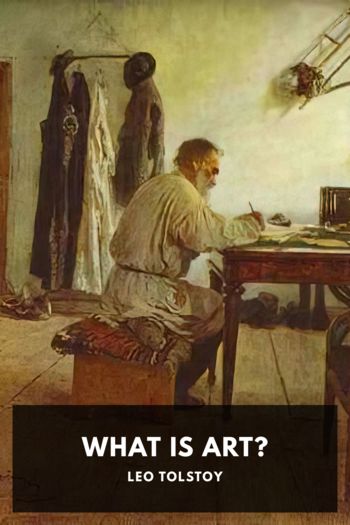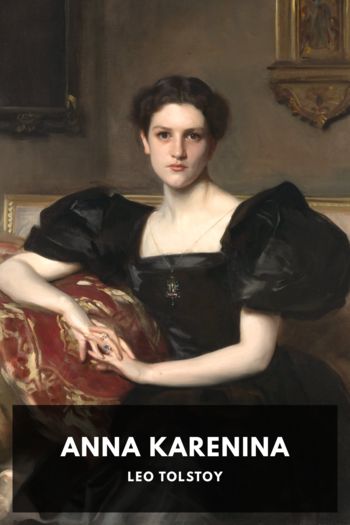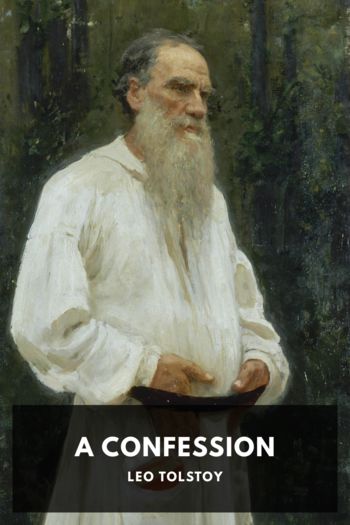What Is Art? by Leo Tolstoy (english readers .txt) 📕

- Author: Leo Tolstoy
Book online «What Is Art? by Leo Tolstoy (english readers .txt) 📕». Author Leo Tolstoy
Art is differentiated from activity of the understanding, which demands preparation and a certain sequence of knowledge (so that one cannot learn trigonometry before knowing geometry), by the fact that it acts on people independently of their state of development and education, that the charm of a picture, of sounds, or of forms, infects any man whatever his plane of development.
The business of art lies just in this—to make that understood and felt which, in the form of an argument, might be incomprehensible and inaccessible. Usually it seems to the recipient of a truly artistic impression that he knew the thing before but had been unable to express it.
And such has always been the nature of good, supreme art; the Iliad, the Odyssey, the stories of Isaac, Jacob, and Joseph, the Hebrew prophets, the psalms, the Gospel parables, the story of Sakya Muni, and the hymns of the Vedas: all transmit very elevated feelings, and are nevertheless quite comprehensible now to us, educated or uneducated, as they were comprehensible to the men of those times, long ago, who were even less educated than our labourers. People talk about incomprehensibility; but if art is the transmission of feelings flowing from man’s religious perception, how can a feeling be incomprehensible which is founded on religion, i.e. on man’s relation to God? Such art should be, and has actually, always been, comprehensible to everybody, because every man’s relation to God is one and the same. And therefore the churches and the images in them were always comprehensible to everyone. The hindrance to understanding the best and highest feelings (as is said in the gospel) does not at all lie in deficiency of development or learning, but, on the contrary, in false development and false learning. A good and lofty work of art may be incomprehensible, but not to simple, unperverted peasant labourers (all that is highest is understood by them)—it may be, and often is, unintelligible to erudite, perverted people destitute of religion. And this continually occurs in our society, in which the highest feelings are simply not understood. For instance, I know people who consider themselves most refined, and who say that they do not understand the poetry of love to one’s neighbour, of self-sacrifice, or of chastity.
So that good, great, universal, religious art may be incomprehensible to a small circle of spoilt people, but certainly not to any large number of plain men.
Art cannot be incomprehensible to the great masses only because it is very good—as artists of our day are fond of telling us. Rather we are bound to conclude that this art is unintelligible to the great masses only because it is very bad art, or even is not art at all. So that the favourite argument (naively accepted by the cultured crowd), that in order to feel art one has first to understand it (which really only means habituate oneself to it), is the truest indication that what we are asked to understand by such a method is either very bad, exclusive art, or is not art at all.
People say that works of art do not please the people because they are incapable of understanding them. But if the aim of works of art is to infect people with the emotion the artist has experienced, how can one talk about not understanding?
A man of the people reads a book, sees a picture, hears a play or a symphony, and is touched by no feeling. He is told that this is because he cannot understand. People promise to let a man see a certain show; he enters and sees nothing. He is told that this is because his sight is not prepared for this show. But the man well knows that he sees quite well, and if he does not see what people promised to show him, he only concludes (as is quite just) that those who undertook to show him the spectacle have not fulfilled their engagement. And it is perfectly just for a man who does feel the influence of some works of art to come to this conclusion concerning artists who do not, by their works, evoke feeling in him. To say that the reason a man is not touched by my art is because he is still too stupid, besides being very self-conceited and also rude, is to reverse the roles, and for the sick to send the hale to bed.
Voltaire said that “Tous les genres sont bons, hors le genre ennuyeux”;81 but with even more right one may say of art that Tous les genres sons bons, hors celui qu’on ne comprend pas, or qui ne produit pas son effet,82 for of what value is an article which fails to do that for which it was intended?
Mark this above all: if only it be admitted that art may be art and yet be unintelligible to anyone of sound mind, there is no reason why any circle of perverted people should not compose works tickling their own perverted feelings and comprehensible to no one but themselves, and call it “art,” as is actually being done by the so-called Decadents.
The direction art has





Comments (0)